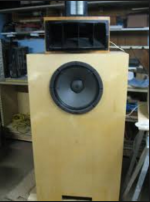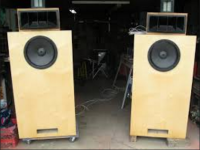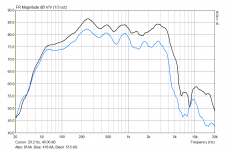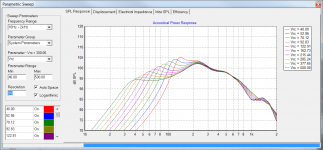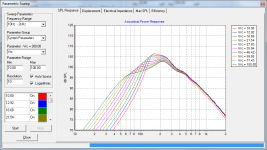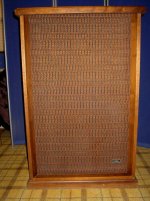That would be awesome to build a M19 like that and MLTL loaded!. Here's a few pics of the Volti cab. I'd do it like this in concept where the horn is in it's own sand or lead filled box sitting on top, and then the cab underneath could be whatever size works for sitted ear height and MLTL loaded with either a single 416 or side by side twin 416's. That would be some great efficiency if the twin 416's could work, or if not a single would still be killer!
Here's one build: Altec 416b MLTL, design by GM
PB is holding the pics hostage, but did manage to copy these two [attached] low res pics off a Google image search, though not sure if he ever added the full width horn baffles with the foams kits I recommended to mimic the M19's.
Horizontally opposed 15" require 511/500 Hz and preferably larger horns tuned lower. My fave Altec consumer speaker is the 830 Laguna: http://www.hifilit.com/Altec/1959-h.jpg
http://www.hifilit.com/Altec/1959-l.jpg
altec 830 Laguna - Google Search
For the 811, the popular dual 12" 9844 studio monitor in maybe a larger cab tuned lower should please: 9844
https://www.google.com/search?q=alt...MB_AQyjcIRA&ei=zjt-WZ3-McvKmQG3mZyADw#imgrc=_
GM
Attachments
What's a "Chapman" horn?
Sold by John Chapman out of Vancouver BC Canada around the same time as Bert Doppelberg(spelling?) was doing his big Oris horns in Europe. Very similar, as they were designed to use Lowther sized drivers. I first used a PM5A, then went with a looooong adapter to mate with the 2001 -after reading Jean Michel LeCleach experiments with using that compression driver to below 300hz on his custom designed horns.
Here's one build: Altec 416b MLTL, design by GM
PB is holding the pics hostage, but did manage to copy these two [attached] low res pics off a Google image search, though not sure if he ever added the full width horn baffles with the foams kits I recommended to mimic the M19's.
Horizontally opposed 15" require 511/500 Hz and preferably larger horns tuned lower. My fave Altec consumer speaker is the 830 Laguna: http://www.hifilit.com/Altec/1959-h.jpg
http://www.hifilit.com/Altec/1959-l.jpg
altec 830 Laguna - Google Search
For the 811, the popular dual 12" 9844 studio monitor in maybe a larger cab tuned lower should please: 9844
https://www.google.com/search?q=alt...MB_AQyjcIRA&ei=zjt-WZ3-McvKmQG3mZyADw#imgrc=_
GM
GM, what's your take on the upper bass/lower mid quality of dual 803's/416's (Laguna) versus a single 515 in an A7-style short horn? I'd guess the A7 short horn has more "snap" at the expense of somewhat uneven bass, while the Laguna has more authority compared to a single-bass-driver Model 19.
P.S. I particularly like the second ad ... I remember when Cinerama and 70mm movies came out, and it was the first time I'd heard real stereo sound. Very different character than modern movie theaters.
GM, what's your take on the upper bass/lower mid quality of dual 803's/416's (Laguna) versus a single 515 in an A7-style short horn? I'd guess the A7 short horn has more "snap" at the expense of somewhat uneven bass, while the Laguna has more authority compared to a single-bass-driver Model 19.
P.S. I particularly like the second ad ... I remember when Cinerama and 70mm movies came out, and it was the first time I'd heard real stereo sound. Very different character than modern movie theaters.
Well, at 500 Hz the duals are 'open'/'relaxed' with a 'fuller' lower mids and definitely a superior bass line as one would expect; whereas the horn is 'pinched', but 'sharp' and yes, very 'fast' with a big drop off in the mid-bass to a minimal upper bass unless tuned lower. The horn was designed for 800 Hz, so not really a fair comparison, but the duals need to be over/under to [barely] use them at 800 Hz and even then only if sitting pretty far away.
Yeah, all my early audio experiences were at the movies. I was very fortunate as we had three major movie palaces and several more smaller ones that were set up specifically for Cinerama, remastered Gone with the Wind, the Sensurround series, etc.. Later, a local suburbs cinema was set up with quadraphonic [A7-500] in the corners + the theater's stereo A5's [with 1005] pushed together to make a huge mono CC along with a then super cool laser show for the feature length music videos, Yessongs, PF's Live at Pompeii, etc.. Jimmy Buffet and some others did some early shows there before they became superstars. Didn't/don't smoke anything, but stayed 'higher than a Ga, Yellow Pine' at those shows
Jeez, I miss those days!
GM
i like.
+1
Did dual 511/802s; got a little more horn, throat area than the much more 'full' sounding 805/288, but with the improved HF of the 1" drivers and at a fraction of the price to boot.
GM
Well, at 500 Hz the duals are 'open'/'relaxed' with a 'fuller' lower mids and definitely a superior bass line as one would expect; whereas the horn is 'pinched', but 'sharp' and yes, very 'fast' with a big drop off in the mid-bass to a minimal upper bass unless tuned lower. The horn was designed for 800 Hz, so not really a fair comparison, but the duals need to be over/under to [barely] use them at 800 Hz and even then only if sitting pretty far away.
GM
Thanks for the real-world experience ... much appreciated!
One possibility I'm exploring is an A7-type horn with a very small closed rear chamber for the 515 ... in the range of 1 cubic foot (or less). Simulations indicate this will extend the response beyond the 220 Hz peaked cutoff of the bass horn, and cover about an octave below cutoff, so the response of the complete system (515 + 1 cu. ft. closed rear chamber + A7 horn) covers 100 Hz to 800 Hz, and is also reasonably flat.
If the horn were removed, the simple direct-radiator+box would have a peak of several dB around 100~120 Hz, but the combination of the horn and the peaked direct-radiator combines to give a reasonably smooth response over the passband. In effect, it's a hybrid ... a direct radiator from 100 Hz to 220 Hz, and a horn from 220 Hz to 800 Hz.
The real A7 does the same thing in principle, but is grossly mistuned, with a 60 Hz peak that is 10~12 dB below the main 220 Hz peak, and response that drops like a stone below the 220 Hz peak.
The catch with a A7+small closed rear chamber is the response only covers 100 to 800 Hz, and drops off very sharply below 100 Hz. So another woofer is needed to cover 30~100 Hz, which doesn't really save any drivers (or space) compared to the dual-416 approach, and a 100 Hz crossover is probably necessary. The main difference in functional terms is probably directivity, with the A7 maintaining some degree of pattern control down to 300 Hz or so, which isn't really true for the dual-woofer approach.
HI ALL,
Sorry to drop my responses. First of I should have said Altec instead of JBL. As much as I would like the GPA stuff, just don't have the funds available. The Emme set is within my reach. As much as I would like to try the MLTL cab, I still need something WAF approved. I was considering something like the 3577A Stonehenge III, with the horn either in the cab or on top, but the original model 19 cab fits her approval better. The SEOS-24 waveguide is interesting as is the Fatal driver/horn. Dual Emme woofers? I'm almost getting lost with all the recommendations.
Just for fun I attached my old UGLY horn setup...lost when I got hitched a VERY log time ago (sorry for the picture quality). If I remember correctly, 515b in 825 cab, 808 driver in what I think was a 203b horn I cut in half so I could have two. Low budget system driven by a PSE 6BX7 amp. In a 12 x 12 bedroom. All I remember it that it rocked!
Sorry to drop my responses. First of I should have said Altec instead of JBL. As much as I would like the GPA stuff, just don't have the funds available. The Emme set is within my reach. As much as I would like to try the MLTL cab, I still need something WAF approved. I was considering something like the 3577A Stonehenge III, with the horn either in the cab or on top, but the original model 19 cab fits her approval better. The SEOS-24 waveguide is interesting as is the Fatal driver/horn. Dual Emme woofers? I'm almost getting lost with all the recommendations.
Just for fun I attached my old UGLY horn setup...lost when I got hitched a VERY log time ago (sorry for the picture quality). If I remember correctly, 515b in 825 cab, 808 driver in what I think was a 203b horn I cut in half so I could have two. Low budget system driven by a PSE 6BX7 amp. In a 12 x 12 bedroom. All I remember it that it rocked!
Attachments
In stock tuning, yes. But that's the first thing you fix.The real A7 does the same thing in principle, but is grossly mistuned, with a 60 Hz peak that is 10~12 dB below the main 220 Hz peak, and response that drops like a stone below the 220 Hz peak.
I think - but can't verify - that a lot of what makes the Altec 825/828 (A7) horn flare work so well is that it's used with a mid/high horn of similar dimensions. The best I've heard is the Altec 1505 horn, which has mouth very close in size to the bass horn flare.
The idea of using the bass flare down to just 100Hz is an interesting one. Would it end up looking like the 816 without ports?
In stock tuning, yes. But that's the first thing you fix.With proper tuning and help from corner loading or wings, the box will play solidly into the 30s. You will have to deal with the 220Hz peak, I always did - bit have seen similar peaks on hornless boxes of the same size.
I think - but can't verify - that a lot of what makes the Altec 825/828 (A7) horn flare work so well is that it's used with a mid/high horn of similar dimensions. The best I've heard is the Altec 1505 horn, which has mouth very close in size to the bass horn flare.
The idea of using the bass flare down to just 100Hz is an interesting one. Would it end up looking like the 816 without ports?
Back when I was working with Bjorn Kolbrek on the AH425, I mentioned an alternative version of the A7 - a much smaller closed-box version using modern optimization techniques. Bjorn, to my surprise, actually owned a pair of A7's at one time, and not only that, measured them in the anechoic chamber of a local University. More recently, he's shown me simulations of the A7 horn combined with different volume rear chambers in both vented and closed alignments. The simulation is surprisingly close to the actual real-world measurement of the A7, so I trust them for the closed-box variant. (Bjorn's data is shown below in Figures 1, 2, and 3.)
My original idea was using the 515 (or 416) without the annoying requirement for an electronic or digital highpass filter. I know that below cutoff, horn-loading acoustically disappears, and the driver acts much as it would without a horn at all. Also, when a vented box is working below the box frequency (Fs), the box provides no acoustic loading ... the driver is effectively in free air, like a dipole.
This is a roundabout way of saying that an A7-style vented rear chamber provides no loading at all below Fs, which is around 60 Hz for the A7. The woofer is free to move, which isn't a good thing with either a 416 or 515, which have short underhung voice-coils and have very limited linear excursion (a few mm at most). In the standard Altec A7 (a rear-vented short horn) or Model 19 (a standard T/S alignment vented system), an active highpass filter is a very good idea, since both are unloaded below the Fs frequency, and this does no favors for the 416 or 515 drivers.
My thought was to use a very small closed rear chamber for the 515, which substantially decreases compliance and thus limits VLF excursion. The trick is selecting the correct rear volume, tuning it to the cutoff of the short bass horn, and taking over below the bass horn cutoff ... dual-mode operation, as it were, and using modern simulation techniques, which weren't available to Altec when the A7 was designed in the mid-Forties.
Figure 1 is Bjorn Kolbrek's anechoic measurement of his A7 with 515 and 416 drivers (416, as expected, is the lower, less efficient curve). Figure 2 is Bjorn's vented simulation of the A7 with different rear-chamber volumes (in liters). Figure 3 is Bjorn's closed-box simulation with different rear-chamber volumes. Note the discrepancy between the measured response and the simulations above 300 Hz; this is due to the increased directivity of the A7 horn, which is not reflected in the simulations, which are total power into the room simulations, and do not take directivity-gain into account.
Attachments
Last edited:
Thanks for the sims, Lynn. I'll study them and get back to you.
As for the woofer displacement in the 828 bass box, it's not a problem in domestic use - at least I never found it to be. Even when I got carried away with Host the Planets or the 1812 overture, my 416s just didn't run into trouble. I can see how they might in a much larger venue, like a cinema or concert.
As for the woofer displacement in the 828 bass box, it's not a problem in domestic use - at least I never found it to be. Even when I got carried away with Host the Planets or the 1812 overture, my 416s just didn't run into trouble. I can see how they might in a much larger venue, like a cinema or concert.
The idea of using the bass flare down to just 100Hz is an interesting one. Would it end up looking like the 816 without ports?
The rear chamber would be way smaller than that. My preliminary drawings have the 515 in a box with a 18" by 18" flush-front surface, which then bolts directly (using 2 bolts each at the corners) to the 18" by 18" wood rear flange of the A7 horn. The rest of the box is a truncated pyramid that closely fits over the magnet.
There's a subtle benefit in a box this small. It's too small to permit standing-wave modes (much smaller than the wavelengths in the 100~800 Hz passband), so it acts similarly to the rear chamber of a compression driver, which is also smaller than wavelengths in the passband.
My guess is one the reasons horns and dipoles have a sonic similarity is the lack of box modes ... the horns might have their own colorations, but these are very different than the generic standing-wave modes of a large closed or vented box. The internal modes of a conventional box might be 20 to 30 dB below the direct sound from the driver, but they are surprisingly audible once you know what they sound like.
This is an extension of the thinking that went into Gary Dahl's system. He's using closed 3.5 cubic foot boxes, which are much smaller than the box used in the A7 or Model 19, and which also restricts the VLF excursion of the 416 drivers. (In Gary's system the compact 416 enclosures are closed, not vented, and the system relies on a subwoofer for below-50 Hz duties.)
Modern subwoofers with high-powered Class AB or Class D transistor amplifiers (and optional equalization) gives us a degree of freedom that didn't exist when the A7, or even the Model 19, were designed.
My thoughts are, why not take advantage of that, and release the restricted-excursion 416 or 515 from low-bass duties? Their real strength is the underhung voice coil (very linear in its travel), an excellent cone free of harsh modes in the HF region, and the well-thought-out damped surround.
P.S. My fallback position is a phase-matched dual-woofer system, each with its own 3.5 cubic foot box, and working more or less in parallel. Maybe even a 515 combined with a 416 for a little extra tonal flavor. This nudges system efficiency just past the magical 100 dB mark, and is a lot more simple than messing around with bass horns. Dual 15's are a classic pro monitor solution, so it's not like it hasn't been tried before.
Last edited:
Altec "Magnificants"
Hi, Great thread. I am in the process of refurbishing a pair of the Magnificants. Apparently a home (or at least prettier version) of the A7-500W. Mine look like the ones in the literature (ca 1972). I have a pair of the GPA alnico 416s, SEOs 15 inch horns and some Radian 475PB-8s are on the way. They were recommended as a better upgrade than the original drivers. Time will tell on that. Corssover is diy second order at 1600HZ. I have had the enclosures for quite some time but the never had the drivers. Very good shape with original grill cloth (unfortunately not the wood ones), Altec badge and even the stuffing. I expect it to take a week or two to try them out.
Hi, Great thread. I am in the process of refurbishing a pair of the Magnificants. Apparently a home (or at least prettier version) of the A7-500W. Mine look like the ones in the literature (ca 1972). I have a pair of the GPA alnico 416s, SEOs 15 inch horns and some Radian 475PB-8s are on the way. They were recommended as a better upgrade than the original drivers. Time will tell on that. Corssover is diy second order at 1600HZ. I have had the enclosures for quite some time but the never had the drivers. Very good shape with original grill cloth (unfortunately not the wood ones), Altec badge and even the stuffing. I expect it to take a week or two to try them out.
Attachments
No problem with a little diversion...I'm enjoying the ride. Is there a way to optimize the 19 cabinet, as the width and height fits my room? I was thinking of a standalone sand filled horn cabinet for the top and resizing the woofer cabinet (deeper) to replace the lost volume. Now leaning towards the faital-tractrix horn. I actuall built a mid-high freq Edgar horn-tractrix a long time ago with a Ramsa driver and liked it...should have never sold it.
The rear chamber would be way smaller than that.
Yeah, with a 515-8G, HR says the magic number is right at 10 L.
GM
- Home
- Loudspeakers
- Multi-Way
- Altec Model 19 Clone
